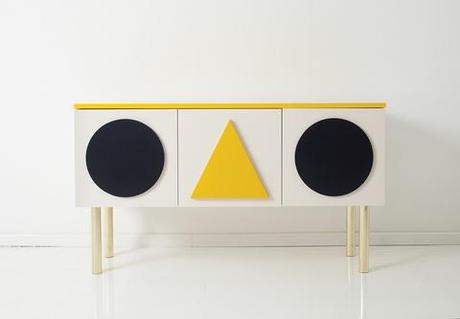
Danish-German designer Gesa Hansen released an Alexander Girard–inspired sideboard in 2013 for the Hansen Family line.
Gesa Hansen comes from a long line of furniture designers. “My mother would take me to all the design fairs from the time I was four,” says Hansen, who is Danish and German. “Furniture is so natural for her,” says the German photographer Nathalie Mohadjer—Hansen’s frequent collaborator and best friend—who shot the images accompanying this story. The two met while studying at the famous Bauhaus University, in Weimar, Germany. “In school, in the product design classes, everyone asked [Gesa], ‘How do you know everything already?’”
Wanting to strike out on her own path, Hansen, whose father is the Danish furniture designer Hans Hansen, got her diploma in product design. “I needed something new, for me,” she says. But by the end of her studies, she had found her way back to furniture.
Slideshow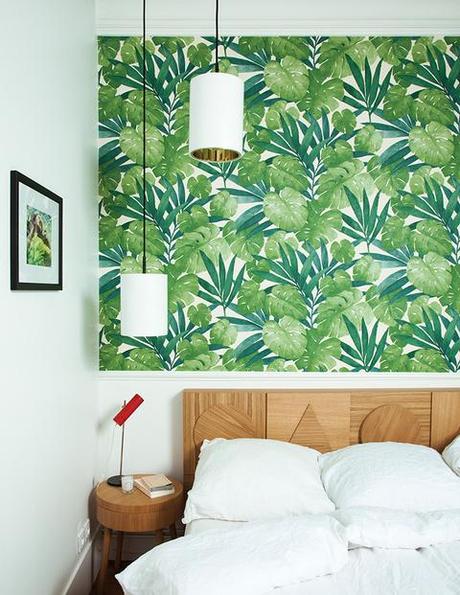
The headboard in Hansen’s bedroom echoes the 2013 side-board. The wallpaper is from Arte.
“I still do graphic design, but it’s a real effort—it’s really work for me,” says Hansen, who moved to Paris to work for the architect Jean Nouvel. “With furniture, it’s building up in my mind the whole time, and at one point it just comes out.”
Family is a recurring theme for Hansen, who launched her own line of furniture under the name the Hansen Family in 2009. Remix is a Scandinavian-influenced collection consisting of a dozen solid-oak pieces—including a slick, but comfy, felt sleeper sofa and
a teardrop-shaped coffee table. “When I created it, it had to do with the idea of ethics,” she says. “Working with local wood, paying people a decent wage. I wanted to do something honest. I didn’t expect it to be so successful.” But it was, winning two Red Dot awards and a
Good Design Award from the Chicago Athenaeum. It also earned a nomination for the 2011 German Design Award.
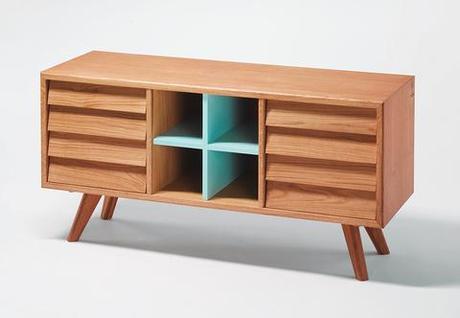
The drawer fronts of the sideboard from the Remix collection were modeled after Scandinavian sailboats.
“I think one is always more inspired by the grandfather’s generation than the father’s generation,” Hansen says, noting that both of her grandfathers worked with wood. “My father was inspired by the Bauhaus. I’m inspired by the Bauhaus as well. But what I’m really drawn to is the 1950s, the wood.”
The Hansen Family label was born when Hansen returned to Paris after a brief, if aesthetically important, stint working in Japan. Frustrated that her designs were undergoing so many changes that she didn’t recognize them when they were finished, she decided to create her own pieces.
On a trip home to Germany, she and her father reopened an old family woodshop and recruited a team to work there. “It’s next to a stream, and the machines are water powered. The river is crystal clear, in the middle of the forest. You feel like you’re in another time. My daughter loves it there,” says Hansen of her three-year-old, Lou.
Slideshow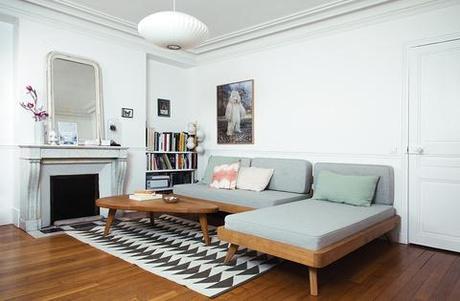
In the living room, Hansen’s convertible Night couch and coffee table join a Black Marble rug by Suki Cheema and Slovenian Bear from Charles Fréger’s Wilder Mann series.
Now that the Hansen Family collection has taken off, Hansen travels regularly between Paris and her German woodshop. While Hansen says she is addicted to Paris for its inimitable sense of chic, she also feels that the city is conducive to her work. “I think I need Paris’s spark,” she explains. “There’s this creative exchange. And it’s important to be here, to maintain those relationships.”
Following her recent divorce, Hansen moved to a ground-floor studio that is just over 500 square feet. The new apartment has prompted several prototypes in just a few short months, including a dining table. “You see,” she says, pointing to a magazine photograph of an early version in her former kitchen, “I just crossed the legs.” Then she added a rounded marble-plate top. “I fixed it in a way you can remove it. So it’s easier for transport.”
Slideshow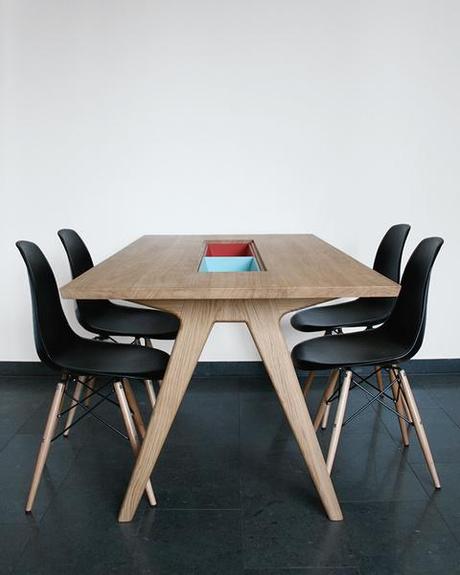
Paired with Eames side chairs, her dining table includes two cases “to either hide or show things,” she says.
Hansen credits her apartment—along with her job as an interior designer—with expanding her material horizons. “My first collection was only wood,” she says. “I’m ready to mix materials.” The marble tabletop, for example, was a result of her cake baking. “I put marble on the kitchen bar because I wouldn’t need a plate. So now, I wake up and see the cake. I can cut a slice and drink a cup of coffee.”
New routines such as this one have inspired Hansen’s current fascination with the idea of ritual. “When Lou comes home now, she always puts her shoes under the tea bench,” a low oak piece that Hansen designed recently in collaboration with a Japanese colleague. “Her favorite place to sit is by the windows, so I’m going to make some cushions for her there.”
“I think ‘ritual’ might even be the name of my next collection,” says Hansen, who looks around the small but comfortable space with palpable satisfaction. “Now I just need a place for my keys.”
